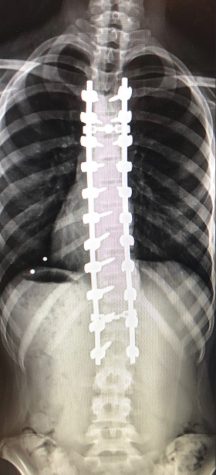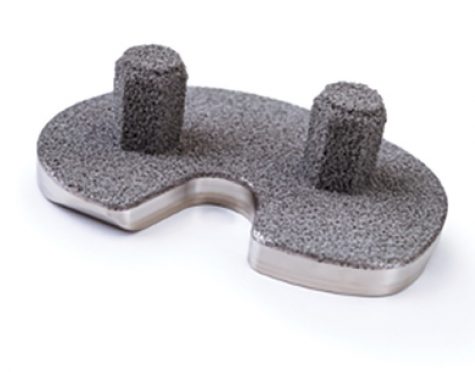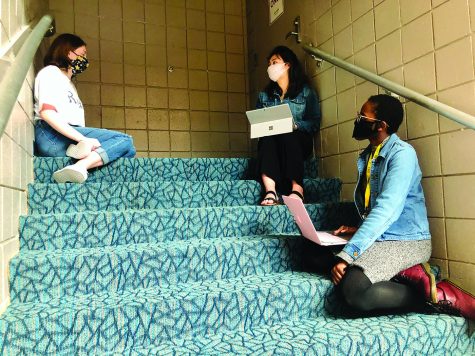From Different Parts
Students with metal implants experience unique challenges
At first glance, senior Luis Withrow’s left arm appears normal. However, there is actually something rather unusual in it: a metal plate. Withrow broke his arm after a skateboarding accident, and the damage was severe enough to warrant placing a plate in his arm to fix it.
“I broke my arm in two places, and it was a pretty bad break,” Withrow said. “Normally, when you break your arm, you get a cast. Well, this was worse than (a normal case), so I guess (the doctors) decided that we shouldn’t have a cast. (They decided they) should do an implant.”
Withrow’s situation is similar to those of other students with metal implants. Senior Lauren Tester had ‘scoliosis’, curvature in the spine, that was so severe that doctors deemed it vital that she receive metal implants in her spine.

This X-ray shows Senior Lauren Tester’s spine after her surgery.The surgery to place these implants took five hours, and Tester stayed in the hospital for five days after that to recover.
Submitted Photo: Lauren Tester

This X-ray shows Senior Lauren Tester’s spine before her surgery. She said her scoliosis caused her organs to shift within her body, making her spine implants necessary.
Submitted Photo: Lauren Tester
“The normal spine is like a straight line, with a tiny degree, but mine, it pretty much made an S-shape, so it shifted some organs, and they found it was vital to correct the curve and straighten it out.”
Tester also said that the discomfort her scoliosis brought her made it necessary to get implants in her back.
“Sitting for a long time or standing for a long time was so uncomfortable,” Tester said.“I was still really flexible in my back, but it felt off. I could just feel that something was off.”
To straighten out Tester’s spine, surgeons placed a metal rod on each side of her spine along with 21 screws in her vertebrae. She underwent this operation last December.
Tester immediately noticed a difference in her posture and body after the surgery.
She said, “I remember, when (the doctors) had me stand up and try to walk, I actually grew 2 inches. I went from being 5 feet, 10 inches6” to 5 feet,8 inches”. Two inches is a big difference, so I noticed that.”
While differences and side effects are inevitable, doctors try their best to make their patients feel as normal as possible after they get metal implants. Michael Meneghini, an orthopedic surgeon who does hip and knee replacements and designs metal implants, said designing implants is a lengthy process that can take years.
“A simple modification to an existing product can take about a year or so, but starting to design a product from start to finish, conceptualizing it, designing it, testing it, getting it through the Food and Drug Administration (FDA) and the government, and going through the regulatory process, that can take anywhere from two to four years.”
To make sure that the implants he designs are suitable for medical use, Meneghini places them in cadavers and tests them for toughness.
“We’ll manufacture some test parts, and we start by implanting them in cadavers, in people who have died and donated their body to science. We do that, and then, once we get through that, then we submit it to the government,” Meneghini said. “The engineers are simultaneously testing it to make sure that the materials perform properly. The FDA has requirements that we have to satisfy and we submit our findings to the FDA. When they approve it, then we can launch it.”
However, the vetting process for implants does not end there. Surgeons then test the new implants by placing them in a few patients.
“We do it in small groups of patients at first and follow them closely,” Meneghini said. “You develop it. You do the trials with a certain number of patients until you know it’s safe. Once it turns out successful, then you can release it to the entire world.”
Although engineers and physicians thoroughly test the implants to make sure they are safe for use and effective, the recovery from the operation is not smooth and immediate. There is a lengthy recovery period after the operation. Withrow said he had very limited use of his left arm after he got his implant.

This photo is an example of an implant used for total knee replacements designed by surgeon Michael Meneghini. He said designing a modified version of an existing implant could take a year, while making a new design could take several.
Submitted photo: Michael Meneghini
“During that period, I couldn’t use my left hand at all. I could use my thumbs. I could still move my hand, but I could not hold a video-game controller. I was basically sitting in my bed watching TV or on my phone,” Withrow said. “I’m a right-hand-dominant person, so it wasn’t as bad as if I broke my right hand, but still, it made daily life difficult. I couldn’t do a lot of things I usually had no trouble with.”
Similarly, recovery limited Tester in her activities following her surgery.
“The recovery was painful. I had to have a lot of help from my parents to stand up even. Throughout the night, they would have to help me roll over because my muscles were so tight.”
Additionally, there are now permanent limitations to her body.
“For the rest of my life, I won’t be able to (do) a back bend or bend backwards because the metal rods restrict me in that way,” Tester said.
To regain function in their bodies, both Withrow and Tester said they had to go through physical therapy.
“After I got the surgery, I had this miniature cast on my arm for the next two and a half months,” Withrow said. “I had to take off this cast for 30 minutes a day and do physical therapy. I would stretch my hand and mildly build up muscle back into this broken arm.”
While Withrow said he did not enjoy the therapy, he said he recognizes that it was necessary, and is glad he underwent this therapy and had this implant.
“To be honest, (physical therapy) was annoying to me. I didn’t like doing it, but I’m glad I did it because (my arm) healed properly,” Withrow said.“(My left arm) feels pretty normal;I’m used to it all now.”
The effects of the implants extended beyond the physical effects for Tester. Tester said the operation and the recovery process helped her determine what she wants to do in life.
“It made me realize that I want to do nursing, because I want to be able to help other people like my nurses helped me,” Tester said.
On a broader level, she said the operation and her recovery from it have shaped her outlook on life.
“I definitely try to be a bit more optimistic. Even in times that are challenging, I try to just know that it’s going to get better. There are going to be rough times and challenges in life, but you have got to push through it. I still have pain. At first, I was angry, and I was like, ‘It should be fixed! I should be fine!’ But now I have adjusted to know that it’s going to get better and I just have to give it time.”






